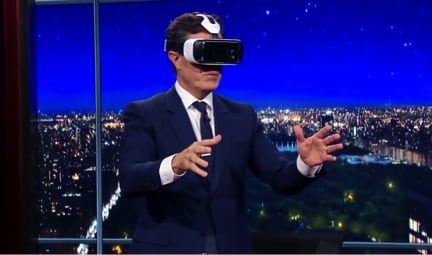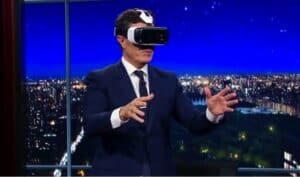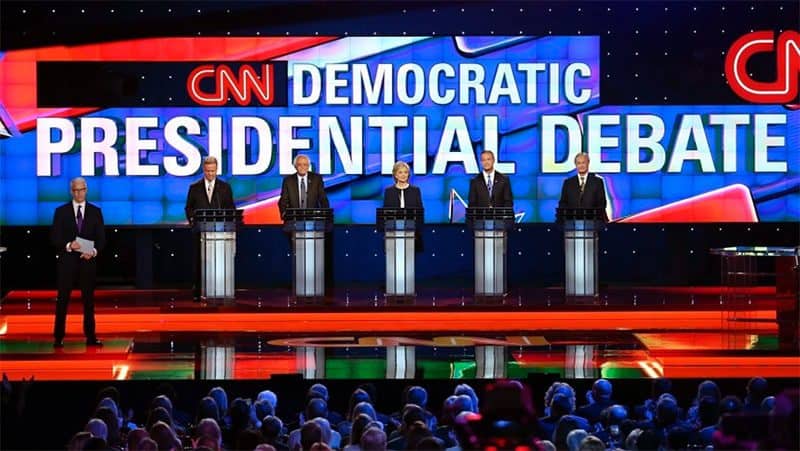We didn’t have the opportunity to experience CNN’s attempt to use Virtual Reality in the political debate last night, but it’s worth reading the reviews. This was live-streaming virtual reality in the political process and surely, it won’t be the last. But like the CNN hologram experience of 2008, this may end up looking less like innovation and more like a media gimmick.
Virtual reality is developing rapidly, but the initial verdict on the CNN experiment was anything but favorable. It may not be suitable for broadcast television.
Stephen Colbert’s mocking review back on October 1st summed up the experience:
It really feels like I’m sitting and watching something I can watch on TV.
The CNN debate in virtual reality
So here’s three perspectives on last night’s democratic debate and how it felt to watch it through Samsung Gear VR. Three different sources, ranging from the popular press (Time Magazine), a more technical review (in The Verge), to the participant’s experience in VR (Slate).
All bring up critical issues as virtual reality makes inroads into journalism, entertainment, education, and other areas. So on to the debate:
Time Magazine
Time Magazine’s Alex Fitzpatrick brought up the different types of VR in, “I Watched the Debate in Virtual Reality”. VR offers an incredible experience when it’s built “from the ground up” using what is unique to the medium. In contrast, the CNN experiment used VR as an enhancement of broadcast television:
This approach is basically taking video as we know it today and slapping it onto a new medium. That’s boring. It’s what we’ve done time and time again when new platforms arise: It feels like online publishers are only just recently tapping into the unique powers of the Internet, for instance, rather than treating it like a dumping ground for stuff that looks a lot like old-school print or video content. VR television will be like 3D TV: A decent enough idea on paper, but never a commercial hit.
For Fitzpatrick, the CNN debate bolted an old medium onto a new one. It’s similar to the way early movies were designed like theatrical productions – it wasn’t cinema, just theater on film. In other words, boring.
The Verge
Adi Robinson in The Verge took on the technical challenges in, “Here’s How to Fix Last Night’s Virtual Reality Presidential Debate“.
Headset screens aren’t going to look as good as flat displays for a long time, and the Gear VR’s was too blurry for me to make out candidates’ faces or even tell most of them apart. And while the Gear VR is as light as full-featured mobile VR gets right now, it’s still not comfortable to wear for hours at a time. You can enjoy VR even with these limitations, but until headsets lose some weight and add a lot of pixels, it’s a real barrier for anybody outside the existing community.
With overly warm headsets and blurry images, it will be some time before anyone wants to wear the devices for an extended period. Are we willing to give up our beautiful hi-definition screens for the opportunity to see a blurry space from different vantagepoints? That kind of novelty quickly wears off.
Slate Magazine
Among the many things noted by Slate’s Katy Waldman in “I Watched the CNN Debate in Virtual Reality” was that the freedom to determine your own viewing angle came with a loss of intimacy. It sounds paradoxical. In Fitzpatrick’s framing of the two kinds of virtual reality, fully immersive experiences can feel very intimate. But that doesn’t hold for live-streaming broadcast events in VR:
One big difference between VR and standard television viewing is that the second gets curated. The camera zooms in on whoever is speaking. When host Anderson Cooper presses Hillary Clinton on whether she’s progressive or moderate, a split-screen materializes to show her reaction as he talks. Not so in VR . . . . It does feel more like a live event, rather than an edited project. You wield a certain freedom to range around, get distracted, and return when the politicians you care about start to speak. But if a bird’s-eye or panoramic view of the action holds a certain grandeur, it comes at the cost of intimacy. There are no furious or touched or triumphant facial expressions to connect with. The debaters look like dolls in a diorama awash in America-colored lights, not like human beings.
Isolation
If there was common agreement among the three and the reaction of others to last night’s “historic” virtual reality experience, it was the disconnection from social media that VR requires. We’re deeply connected and text, talk, and share ideas through a variety of platforms as we watch television. You could say it’s become a much more social experience, though the social dynamic spreads far beyond the people we watch with, and now includes people we share strong or weak bonds with remotely.
A final observation
In time, this will change, and we’ve seen the power of virtual reality when it immerses you in a completely different environment. But at the moment, VR and live-streaming television remains a gimmick, a novelty experience that can quickly lose its allure. As Jeremy Bailenson, founding director of Stanford University’s Virtual Human Interaction Lab, put it:
Used properly, virtual reality is poised to transform the way we engage with our world and with each other. A political debate is not one of those scenarios. The bottom line is that just because an event can be experienced in virtual reality, doesn’t mean it should be.
Like Colbert said, it’s “like watching something I can watch on TV.”
Only worse.
Emory Craig is a writer, speaker, and consultant specializing in virtual reality (VR) and artificial intelligence (AI) with a rich background in art, new media, and higher education. A sought-after speaker at international conferences, he shares his unique insights on innovation and collaborates with universities, nonprofits, businesses, and international organizations to develop transformative initiatives in XR, AI, and digital ethics. Passionate about harnessing the potential of cutting-edge technologies, he explores the ethical ramifications of blending the real with the virtual, sparking meaningful conversations about the future of human experience in an increasingly interconnected world.


